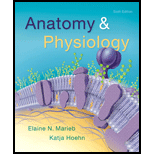
Anatomy & Physiology (6th Edition)
6th Edition
ISBN: 9780134156415
Author: Elaine N. Marieb, Katja N. Hoehn
Publisher: PEARSON
expand_more
expand_more
format_list_bulleted
Concept explainers
Textbook Question
Chapter 4, Problem 5MC
The membrane which lines body cavities that open to the exterior is a(n) (a) endothelium, (b) cutaneous membrane, (c) mucous membrane, (d) serous membrane.
Expert Solution & Answer
Want to see the full answer?
Check out a sample textbook solution
Students have asked these similar questions
Explain in a small summary how:
What genetic information can be obtained from a Punnet square? What genetic information cannot be determined from a Punnet square?
Why might a Punnet Square be beneficial to understanding genetics/inheritance?
In a small summary write down:
Not part of a graded assignment, from a past midterm
Chapter 4 Solutions
Anatomy & Physiology (6th Edition)
Ch. 4.1 - Prob. 1CYUCh. 4.1 - Prob. 2CYUCh. 4.2 - Epithelial tissue is the only tissue type that has...Ch. 4.2 - Prob. 4CYUCh. 4.2 - Stratified epithelia are built for protection or...Ch. 4.2 - Some epithelia are pseudostratified. What does...Ch. 4.2 - Where is transitional epithelium found and what is...Ch. 4.3 - What are four functions of connective tissue?Ch. 4.3 - What are the three types of fibers found in...Ch. 4.3 - Which connective tissue has a soft weblike matrix...
Ch. 4.3 - What type of connective tissue is damaged when you...Ch. 4.3 - Prob. 12CYUCh. 4.4 - You are looking at muscle tissue through the...Ch. 4.4 - Which muscle type(s) is voluntary? Which is...Ch. 4.5 - How does the extended length of a neurons...Ch. 4.6 - What type of membrane consists of epithelium and...Ch. 4.6 - What type of membrane lines the thoracic walls and...Ch. 4.6 - MAKING CONNECTIONS The two layers of serous...Ch. 4.7 - Prob. 19CYUCh. 4.7 - Why does a deep injury to the skin result in...Ch. 4 - Use the key to classify each of the following...Ch. 4 - An epithelium that has several layers, with an...Ch. 4 - Match the epithelial types named in column B with...Ch. 4 - The gland type that secretes products such as...Ch. 4 - The membrane which lines body cavities that open...Ch. 4 - Scar tissue is a variety of (a) epithelium, (b)...Ch. 4 - Define tissue.Ch. 4 - Name four important functions of epithelial tissue...Ch. 4 - Describe the criteria used to classify covering...Ch. 4 - Prob. 10SAQCh. 4 - Provide examples from the body that illustrate...Ch. 4 - Name the primary cell type in connective tissue...Ch. 4 - Name the two major components of matrix and, if...Ch. 4 - Matrix is extracellular. How does the matrix get...Ch. 4 - Name the specific connective tissue type found in...Ch. 4 - What is the function of macrophages?Ch. 4 - Differentiate between the roles of neurons and the...Ch. 4 - Compare and contrast skeletal, cardiac, and smooth...Ch. 4 - Describe the process of tissue repair, making sure...Ch. 4 - In what ways are adipose tissue and bone similar?...
Knowledge Booster
Learn more about
Need a deep-dive on the concept behind this application? Look no further. Learn more about this topic, biology and related others by exploring similar questions and additional content below.Similar questions
- Noggin mutation: The mouse, one of the phenotypic consequences of Noggin mutationis mispatterning of the spinal cord, in the posterior region of the mouse embryo, suchthat in the hindlimb region the more ventral fates are lost, and the dorsal Pax3 domain isexpanded. (this experiment is not in the lectures).a. Hypothesis for why: What would be your hypothesis for why the ventral fatesare lost and dorsal fates expanded? Include in your answer the words notochord,BMP, SHH and either (or both of) surface ectoderm or lateral plate mesodermarrow_forwardNot part of a graded assignment, from a past midtermarrow_forwardNot part of a graded assignment, from a past midtermarrow_forward
- please helparrow_forwardWhat does the heavy dark line along collecting duct tell us about water reabsorption in this individual at this time? What does the heavy dark line along collecting duct tell us about ADH secretion in this individual at this time?arrow_forwardBiology grade 10 study guidearrow_forward
arrow_back_ios
SEE MORE QUESTIONS
arrow_forward_ios
Recommended textbooks for you
 Human Physiology: From Cells to Systems (MindTap ...BiologyISBN:9781285866932Author:Lauralee SherwoodPublisher:Cengage Learning
Human Physiology: From Cells to Systems (MindTap ...BiologyISBN:9781285866932Author:Lauralee SherwoodPublisher:Cengage Learning Human Biology (MindTap Course List)BiologyISBN:9781305112100Author:Cecie Starr, Beverly McMillanPublisher:Cengage Learning
Human Biology (MindTap Course List)BiologyISBN:9781305112100Author:Cecie Starr, Beverly McMillanPublisher:Cengage Learning Comprehensive Medical Assisting: Administrative a...NursingISBN:9781305964792Author:Wilburta Q. Lindh, Carol D. Tamparo, Barbara M. Dahl, Julie Morris, Cindy CorreaPublisher:Cengage Learning
Comprehensive Medical Assisting: Administrative a...NursingISBN:9781305964792Author:Wilburta Q. Lindh, Carol D. Tamparo, Barbara M. Dahl, Julie Morris, Cindy CorreaPublisher:Cengage Learning

Human Physiology: From Cells to Systems (MindTap ...
Biology
ISBN:9781285866932
Author:Lauralee Sherwood
Publisher:Cengage Learning



Human Biology (MindTap Course List)
Biology
ISBN:9781305112100
Author:Cecie Starr, Beverly McMillan
Publisher:Cengage Learning

Comprehensive Medical Assisting: Administrative a...
Nursing
ISBN:9781305964792
Author:Wilburta Q. Lindh, Carol D. Tamparo, Barbara M. Dahl, Julie Morris, Cindy Correa
Publisher:Cengage Learning

Types of Human Body Tissue; Author: MooMooMath and Science;https://www.youtube.com/watch?v=O0ZvbPak4ck;License: Standard YouTube License, CC-BY